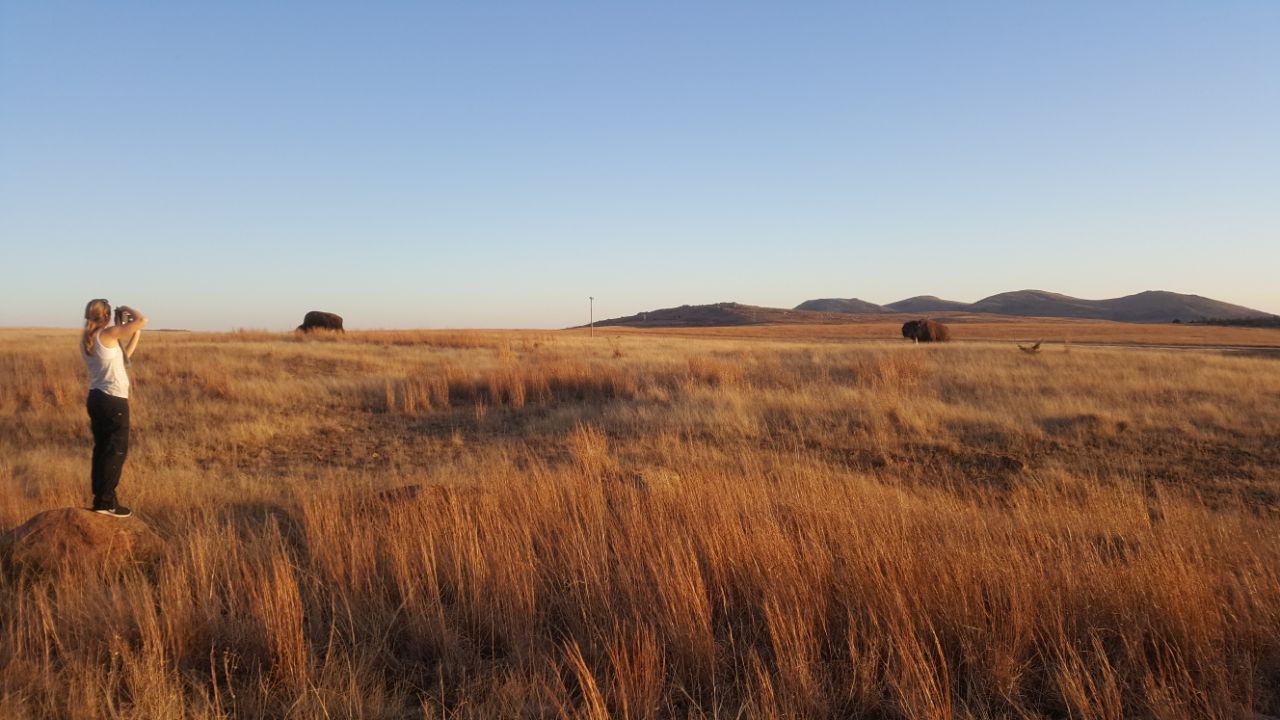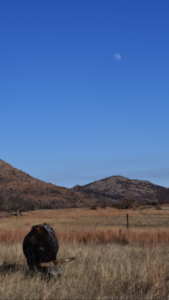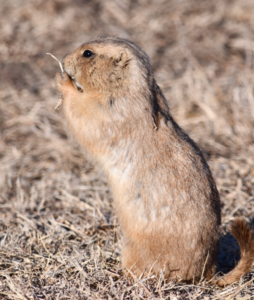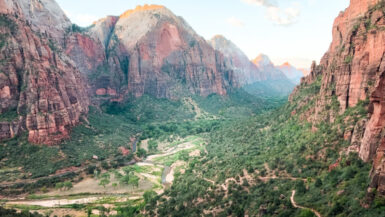Where to see Buffalo in Oklahoma? Wichita Mountains Wildlife Refuge is located right outside of Lawton and Cache and is a great location to spot buffalo. This Wildlife Refuge is most well known for the Buffalo AKA Bison herd that occupies the perimeter. These buffalo can be seen roaming the Oklahoma plains, making for an iconic American photo opportunity.
Finding bison in the Wichita Mountains Wildlife Refuge in Oklahoma is a captivating experience that brings visitors face-to-face with the majestic American bison. The refuge, spanning over 59,000 acres, provides a vast and diverse landscape for these iconic creatures. Bison can often be found grazing in the expansive grasslands or meandering through the rocky hills of the refuge.
One notable area to encounter bison is the Wichita Mountains Bison Prairie, a designated region within the refuge where these magnificent animals freely roam. The park’s population of bison fluctuates, but it’s estimated that there are several hundred individuals, allowing for excellent opportunities to observe them in their natural environment.
The likelihood of seeing bison during a visit to the Wichita Mountains Wildlife Refuge is quite high, especially in areas like the Bison Prairie and along the refuge’s scenic drives. Visitors are encouraged to explore during the cooler parts of the day when bison are more active. Additionally, guided tours and interpretive programs offered by the refuge enhance the chances of encountering and learning about these fascinating creatures. As with any wildlife observation, patience and respect for the animals and their habitat contribute to a rewarding and memorable experience in the presence of the Wichita Mountains bison.
In addition to the buffalo, the refuge is 59,000 acres large and is home to American Bison, Longhorn Cattle, prairie dogs, elk, and deer.
Difference Between Buffalo and Bison
The terms “buffalo” and “bison” are often used interchangeably, but there are distinctions between the two. True buffalo are native to Africa and Asia, such as the African buffalo (Syncerus caffer) and the water buffalo (Bubalus bubalis) in Asia. On the other hand, what are commonly referred to as buffalo in North America are actually bison.
Bison, specifically the American bison (Bison bison), are native to North America and are the iconic large mammals that roamed the plains in vast herds. In the context of North America, the terms “buffalo” and “bison” are often used interchangeably, but the correct term is “bison.”
In Oklahoma, it is the American bison that historically inhabited the region. Today, bison can still be found in parts of Oklahoma, both in private ranches and in protected areas. The Tallgrass Prairie Preserve in Oklahoma, for example, is home to a significant population of American bison and offers opportunities for visitors to observe these iconic creatures in a natural setting.
Why are there bison at Wichita Mountains Wildlife Refuge
The presence of bison at the Wichita Mountains Wildlife Refuge is rooted in a conservation effort aimed at preserving the iconic American bison and their natural habitat. Historically, bison roamed freely across the North American plains, but overhunting and habitat loss led to a severe decline in their population. By the late 1800s, bison were on the brink of extinction.
To safeguard the species, wildlife conservationists and government agencies took significant steps to establish refuges and protected areas where bison could thrive. The Wichita Mountains Wildlife Refuge in Oklahoma became one such sanctuary, providing a suitable environment for bison to roam and ensuring the preservation of this keystone species.
Today, the refuge is home to a stable and carefully managed population of American bison. The presence of these bison contributes to the ecological health of the region, promoting biodiversity and maintaining the natural balance of the ecosystem. Visitors to the Wichita Mountains Wildlife Refuge have the opportunity to witness these majestic creatures in a setting reminiscent of the historic American plains, while also supporting ongoing conservation efforts for the benefit of future generations.
Interacting with Wildlife
You would think that the animals at Wichita Mountains Wildlife Refuge are tame, or domesticated cattle animals.
They are not. This is why the refuge is a great place to see buffalo in Oklahoma. These animals are free to roam animals and a graze by themselves. This means this is a perfect naturalist experience. While they are confined to a large reserve – you can still observe them in a natural habitat for a true experience of buffalo in their environment (which is mainly just eating the grass).
Despite being wild animals, it goes without fail, that there are always individuals that will go and try to interact with these animals up close, bison or Longhorn, and sometimes result in some fatal accidents.
Just like with any wildlife, respect the distance. Here are some tips to observing wildlife while at Wichita Mountains Wildlife Refuge:
- Maintain your distance, sometimes just rolling down the vehicle window to catch a photo of the bison crossing the street is enough.
- Do not approach wildlife, keep a safe distance and preferably a buffer between you and the animal. If you are to exit a vehicle and it is nearby, keep the car door open and take a photo around the car door. This is especially for bison and the longhorn.
- While it is not known for the animals to charge people, it is better to take precautions than it is to act like the animals are pets and approach them. These animals either have large horns (longhorns) or are just massive such as bison, so it is best to just respect their space and observe them doing their natural thing in peace.
Wildlife at Wichita Mountains Wildlife Refuge
If you want to spot a buffalo in Oklahoma, this is a great location to try and enjoy them in their habitat without too much of a search required.
As previously stated there is a moderate amount of wildlife to be found at Wichita Mountains Wildlife Refuge. Here are some of the Oklahoma animals that can be found at this park:
- Bison
- Elk
- Deer
- LongHorn Cattle
- Prairie Dogs
Now let’s go further into detail about where you can spot each of these type of animals at the Wichita Mountains Wildlife Refuge.
Buffalo (Bison) at Wichita Mountains Wildlife Refuge

The downside is that if you are looking for a quick answer on where to spot the Bison, then, unfortunately, I cannot give you one.
The herd wanders all over the Wichita Mountains Wildlife Refuge. Which makes it difficult to say, “Go here and you’ll find them!”. As they can be just about anywhere eating grass in the refuge.
To be honest with you all, during my first trip to the refuge, I actually did not see any. I drove all over the refuge, even hiked up one of the little hills in hopes of spotting some out in the distance, and did not see any.
But do not fear, the second time when I was driving into the park there was some just hanging out right next to Cache Meers Rd (the main road to the park)!
Ultimately, there is no exact place to find the Bison, but the park is easy to navigate by road. I recommend driving along the main road of Cache Meers Road and checking along the rolling hills that way. If they are not off the main strip then the next best chance of spotting them is heading towards Rush Lake or Lake Jed Johnson and hoping that they may be over by the water.
Longhorn at Wichita Mountains Wildlife Refuge
It’s a chance of luck to see a buffalo at Wichita Mountains Wildlife Refuge, and just that that is difficult to say where you will find Longhorn.
I will note that during all my visits, I did see at a minimum one longhorn.
Sometimes the longhorn will be found herding with the Bison. Other times, you will find a lone bull wandering by itself. You can spot the Longhorns from a good distance away.
I will say, that the Longhorns are easier to spot than the bison. I do not know if it is due to the number of them, or perhaps that the Longhorn is more accustomed to people. But during all my trips there were always longhorn present off of the main road. So at a minimum, the longhorn can be an animal you can photograph at Wichita Mounts Wildlife Refuge.
Prairie Dogs at Wichita Mountains Wildlife Refuge
These are one wildlife that you are more guaranteed to see during a visit to the Wichita Mountains Wildlife Refuge due to the fact they do not roam such as longhorn or Bison.
One of the best areas to see Prairie Dogs is over by the Holy City of the Wichitas. At the intersection to turn to the Holy City of the Wichitas you will find a family of prairie dogs in the field leading up to it. They will be hard to miss as they are typically out and about. Just stop your car and pull off to the side and you can watch them doing their thing.
If you get out of your car you will observe them warning the alarm, starting to chirp or “scream” as they notify other ones of a potential danger and if you try to get close then they will quickly escape into the tunnels underground.
Sunset at Mt. Scott
After trying to observe the wildlife at Wichita Mountains Wildlife Refuge then head up Mt Scott to catch the sunset.
Given that most of Oklahoma are flat or rolling hills, Mt Scott offers some amazing view outs over the area.
Just drive up and find an open parking spot on the top of the mountain (the highest point in the area). Back in the park to a spot, move into the trunk of the car (if you have an SUV) and enjoy the sunset with your significant other.
If you haven’t ate snacks already on the trip, this is a great picnic location!
Visiting Wichita Mountains Wildlife Refuge
There are two main entrances:
- From I-44 take Highway 49 (exit 45). Go west 7 miles to the Refuge gate or 14 miles to the Visitor Center.
- If coming from Highway 62, take Highway 115 (Cache exit) north to the Refuge Gate.
This will bring you onto the main road, which will take you to the various turn off either to Mt. Scott or to the Lake, or Church.
Learn more about the Wichita Mountains park here.
Frequently asked questions about seeing Bison at Wichita Mountains
- Where can I see bison in the Wichita Mountains Wildlife Refuge? Bison can be observed in various areas of the refuge, with the Bison Prairie being a notable location. Scenic drives and hiking trails also provide opportunities to encounter these majestic creatures.
- How large is the Wichita Mountains Wildlife Refuge? The refuge spans over 59,000 acres, offering a diverse landscape for wildlife, including the American bison.
- What is the population of bison in the refuge? The population of bison in the Wichita Mountains Wildlife Refuge fluctuates but is estimated to be several hundred individuals.
- When is the best time to see bison? Bison are more active during the cooler parts of the day, so early mornings and late afternoons offer better chances for sightings.
- Are there guided tours to see bison? Yes, the refuge offers guided tours and interpretive programs that enhance the chances of encountering and learning about the bison.
- How close can visitors get to the bison? It is essential to maintain a safe distance from bison and other wildlife. Visitors should adhere to guidelines and respect the animals’ natural behaviors.
- What other wildlife can be seen in the refuge? In addition to bison, the refuge is home to elk, prairie dogs, deer, and a variety of bird species, providing a rich wildlife viewing experience.
- Is there an entrance fee to the Wichita Mountains Wildlife Refuge? There is no entrance fee to the refuge, making it an accessible destination for wildlife enthusiasts.
- Are there facilities, such as restrooms and visitor centers, in the refuge? Yes, the refuge has facilities, including restrooms and visitor centers, providing information about the wildlife and the natural history of the area.
- Can I bring pets to the refuge? To ensure the safety of both visitors and wildlife, pets are not allowed in certain areas of the refuge. It’s essential to check and adhere to the refuge’s pet policy.











Leave a reply